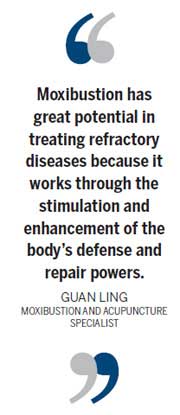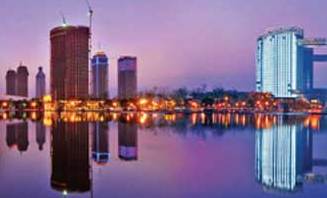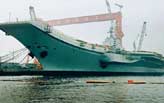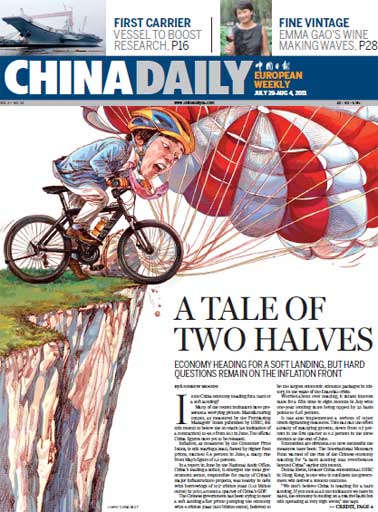Turning up the heat
Updated: 2011-07-22 11:55
By Liu Zhihua (China Daily European Weekly)
 |
|
Through the introduction of heat, moxibustion stimulates certain acupuncture points helping to restore ideal balance. Provided to China Daily |
Traditional Chinese medicine using moxa, or mugwort herb, is once again becoming fashionable
No matter how busy the schedule, the 43-year-old Beijing-based entrepreneur regularly visits Guo Ai Tang, a moxibustion center near her home.
Xi, who declines to give her full name, established the weekly routine earlier this year when seeking traditional Chinese medicine (TCM) therapy to ease pain caused by a three-year-old mammary gland hyperplasia - a benign, often drastic enlargement of the mammary glands.
Previously, she had turned down an operation suggested by her doctor to remove the apricot-stone-sized lump.
"The idea of an operation was repellent and I recalled that when I was a kid, my grandmother used to have moxibustion when she fell ill," Xi says.
On her first visit to Guo Ai Tang, which she chose for its convenient location and reputation after an online search, she answered a questionnaire about common physical irritations and had a brief conversation with a practitioner.
To her great surprise, the practitioner quickly figured out her illness.
She was directed to go into a private room that was filled with the sounds of soft music, change into pajamas and lie down.
A moxibustionist lit one end of a moxa stick, or dried mugwort herb, roughly the shape and size of a cigar, and held it close to her skin to heat four acupuncture points, one after the other, each for about 15 to 20 minutes.
At the same time, several small cans containing burning moxa were placed on another five acupuncture points to warm up the areas.
When the skin became too hot, the practitioner stroked the area to ease the discomfort.
The process lasted about 80 minutes, including a 10-minute massage.
 |
"I felt so relaxed during treatment that I often fell asleep. I didn't expect the effect to be so stunningly good."
Moxibustion, although not so popular as acupuncture, is actually older as a medical practice.
Li Weiheng, president of China Association of Acupuncture and Moxibustion, says moxibustion appeared as soon as Chinese learned to use fire, and gradually became one of the first methods used to fight disease and keep fit in ancient times.
It was believed that moxibustion directly replenishes yang energy in the body to alleviate conditions caused by a deficiency of the yang factor, such as indigestion, shortness of breath, fatigue, menstruation pain and problems with the neck, shoulders, waist and legs.
In the Tang (AD 618-907) and Song (960-1279) dynasties, the popularity of moxibustion reached a peak among people from all walks of life.
However, the therapy declined during the Qing Dynasty (1644-1911), when the emperors' doctors believed it was indecent for the supreme ruler to expose his body to acupuncture and moxibustion.
After the foundation of the People's Republic of China, moxibustion was lumped with "superstitious" TCM, and lagged behind acupuncture in terms of global exposure.
But today it has made a comeback and there are two forms: direct and indirect.
In the former, a small amount of mugwort is placed on top of an acupuncture point and burned. This form of moxibustion is further defined as scarring and non-scarring.
With scarring moxibustion, the mugwort is placed on a point, ignited and burns out completely. This treatment will lead to blisters and scarring after healing.
With non-scarring moxibustion, the mugwort is extinguished or removed before it burns the skin.
When using the indirect moxibustion procedure, a practitioner uses a lit mugwort stick or a can with burning mugwort, to warm the desired points. This was the therapy Xi underwent.
Although acupuncture is widely known by both Chinese and foreigners, moxibustion is not so highly regarded, especially in hospitals.
"Most hospitals don't practice moxibustion," says Guan Ling, an acupuncture and moxibustion specialist with the 301 Military Hospital in Beijing.
The reasons, she explains, are that moxibustion, which requires one-on-one service, is time- and energy-consuming and therefore not profitable and people are not willing to tolerate the smoke or scarring.
Indirect moxibustion is the most popular form, according to experts.
Six years ago, Kang Liguo, at that time a sales manager at a major IT company, led such a full working and busy social life that his health started to suffer.
He underwent a course of moxibustion therapy and to his great surprise, found his health significantly improve.
Inspired and curious, Kang learned all he could about moxibustion and was fascinated by its history. He finally decided to quit his job.
"I saw a great business opportunity because I believed in the affect of moxibustion," Kang says.
In 2005, he founded a company selling moxibustion tools and training programs, and in 2007, opened Guo Ai Tang, in Beijing, which now has three branches.
"Guo Ai Tang is one of the earliest moxibustion centers in Beijing, even in China," Kang says.
"At first, people knew little about moxibustion and we needed to explain, to encourage people to try it out. Now, dozens of moxibustion centers are emerging and more people are enjoying its benefits.
"I'm encouraged. As a businessman I want to make money first but I'm also glad the ancient therapy is acquiring new life."
From 2008, Guan's acupuncture and moxibustion department has been cooperating with other departments at the hospital to help patients with autoimmune and chronic diseases. Many patients have been cured, and most enjoy a less troubled life.
"Moxibustion has great potential in treating refractory diseases," Guan says. "Because it works through the stimulation and enhancement of the body's defense and repair powers."
Guan says TCM considers the human body as a whole, and is designed to create balance between the internal organs and the entire body. "When people get ill, it is the result of a loss of the perfect balance," Guan says.
"Through the introduction of heat, blistering and scarring, moxibustion stimulates certain acupuncture points and provokes the body to restore the ideal balance.
"We should do more research on moxibustion to make more use of the ancient therapy."
E-paper

Double vision
Prosperous Hangzhou banks on creative energies to bridge traditional and modern sectors
Minding matters
A touch of glass
No longer going by the book
Specials

Carrier set for maiden voyage
China is refitting an obsolete aircraft carrier bought from Ukraine for research and training purposes.

Pulling heart strings
The 5,000-year-old guqin holds a special place for both european and Chinese music lovers

Fit to a tea
Sixth-generation member of tea family brews up new ideas to modernize a time-honored business
